
The Nuclear Science and Security Consortium Virtual Learning Series has been planned to support continued connection between students and national laboratory subject matter experts, particularly during the current global pandemic.
Upcoming Events:
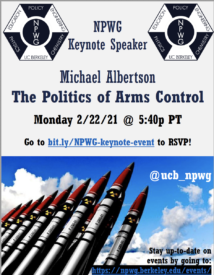
The Nuclear Policy Working Group at Berkeley is hosting their semesterly keynote speaker next week, Monday 2/22/21 @ 5:40p. NPWG will be hosting Mr. Michael Albertson, the deputy director of the Center for Global Security Research at LLNL, who will be talking about the Politics of Arms Control. The event is open to all, but requires registration at https://bit.ly/NPWG-keynote-event.
Abstract: Reductions, bans, limitations, bilateral, multilateral, confidence building measures, legally binding treaties. Arms control is a field that doesn’t lack for ideas on what to do next. Ideas will never come to fruition, however, without a deeper understanding of bureaucratic dynamics, processes, and politics. Although often overlooked in the present discussions of arms control, these are the factors that have to be understood and overcome to make thoughts into practicable proposals and durable agreements that can run the gauntlets of interagency meetings, bilateral negotiations, and Congressional scrutiny. This understanding is especially important given the generational turnover in arms control, as the senior experts from the golden age of arms control in the 1980s and 1990s cede the stage to an emerging cadre of people interested in making a difference in the field.
Bio: Michael Albertson is deputy director of the Center for Global Security Research (CGSR) at Lawrence Livermore National Laboratory. Prior to his current position at CGSR, he served for 16 years in the federal government handling a wide variety of deterrence and arms control-related portfolios for various organizations. From November 2018 to September 2020 he was a senior policy advisor in the Office of the Secretary of Defense (OSD) in the Office of Nuclear and Missile Defense Policy, facilitating extended deterrence dialogues with NATO and Asian allies. Before OSD, Mr. Albertson worked as a team lead in the Department of State’s Office of Strategic Stability and Deterrence Affairs from 2015 to 2018 on Russian strategic nuclear arms control issues including implementation and compliance of the INF Treaty and New START Treaties. He served from 2013 to 2014 on the National Security Council Staff as a director for Russia covering Russian military-security issues; from 2010 to 2012 as a policy advisor to the senior advisor for Arms Control and Strategic Stability to the Under Secretary of Defense (Policy) participating in the negotiation, ratification, and implementation of the New START Treaty; and from 2004 to 2010 as an intelligence analyst and then senior intelligence analyst in the Department of Defense studying Russian military capabilities and doctrine. He holds a B.A. in international relations and government from Claremont McKenna College, an M.S. in strategic intelligence from the National Defense Intelligence College, and an M.A. in security policy studies from George Washington University.
Will Johnson
Staff Physicist at Sandia National laboratories,
Applied Gamma Spectroscopy using InterSpec
Monday 3.15.2021 1:30 pm ET
More information here.
Past events:
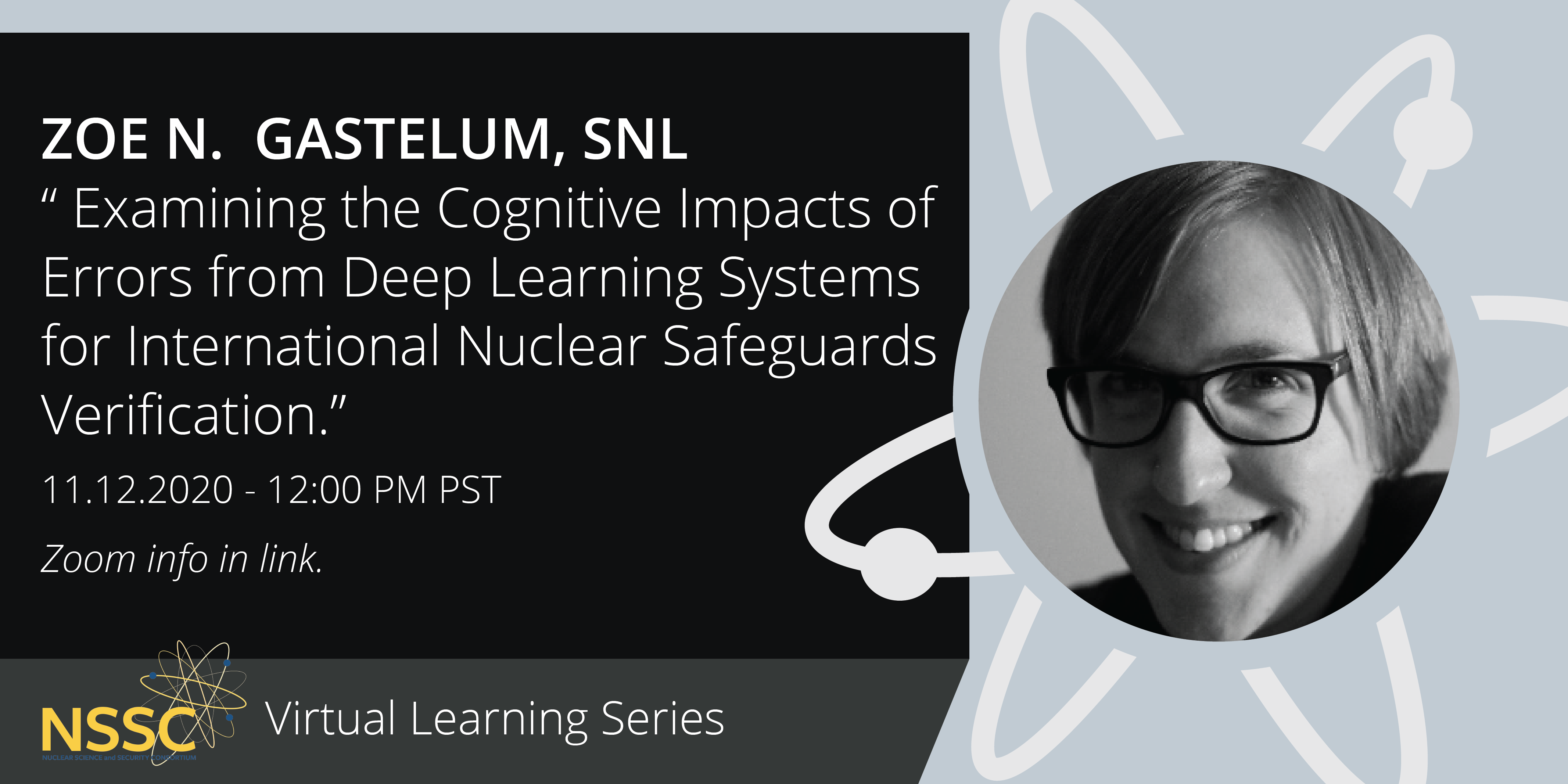
Abstract: Recent improvements in deep learning (DL) performance have led to interest and potential adoption among several high consequence decision making domains. One domain considering the implementation of DL models is international nuclear safeguards, where DL is being investigated for tasks involving open source information collection and analysis, and review of surveillance camera footage. While deep learning applications such as numeral recognition and common image classification are seeing performance that exceeds human ability, other domains still have significant progress to make before reaching human performance levels. Mistakes from DL models can differ in nature from typical human errors, and it is not yet fully understood how these errors impact human users. This work examines the impact of DL errors on human cognitive performance metrics such as time and accuracy, and attempts to approach model trust, within the context of international nuclear safeguards verification applications.
Bio: Zoe Gastelum is a Principal Member of the Technical Staff in the International Safeguards and Engagements Department at Sandia National Laboratories. Zoe has worked at Sandia since February 2015, in which time her research has focused on information sources, analytical techniques, and methods for open source and other data analysis supporting international nuclear safeguards, and the performance of human information systems. Prior to joining Sandia, Zoe spent five years as a nonproliferation research scientist at Pacific Northwest National Laboratory conducting research projects on computational models and methods for information analysis in support of nuclear nonproliferation objectives, focusing on open source data analysis and human behavioral modeling, and advanced information and communication technologies for international nuclear safeguards. Zoe also spent two years as a safeguards information analyst in the International Atomic Energy Agency’s Department of Safeguards, where she led the content development and distribution of a daily safeguards morning briefing for the Department of Safeguards, and conducted open source information analysis for over 20 countries per year.
Zoe is the co-chair the Institute of Nuclear Materials Management (INMM) Working Group on Open Source and Geospatial Information, and the vice- chair of the European Safeguards Research and Development Association’s Verification Technologies and Methodologies Working Group. As of 2020, Zoe is the deputy chair of the INMM International Safeguards Technical Division.
Zoe earned a BA in Political Science from the University of New Mexico, where she graduated summa cum laude with honors in International Studies. She holds a MA in International Security from the University of Texas at Austin’s Teresa Lozano Long Institute of Latin American Studies and has a graduate certificate in International Nuclear Law from the Université Montpellier 1 in France.
Join Zoom Meeting at 11/12/2020 at Noon PST
https://berkeley.zoom.us/j/172057604
Meeting ID: 172 057 604
+16692192599,,172057604# US (San Jose)
+16699006833,,172057604# US (San Jose)
Past events:
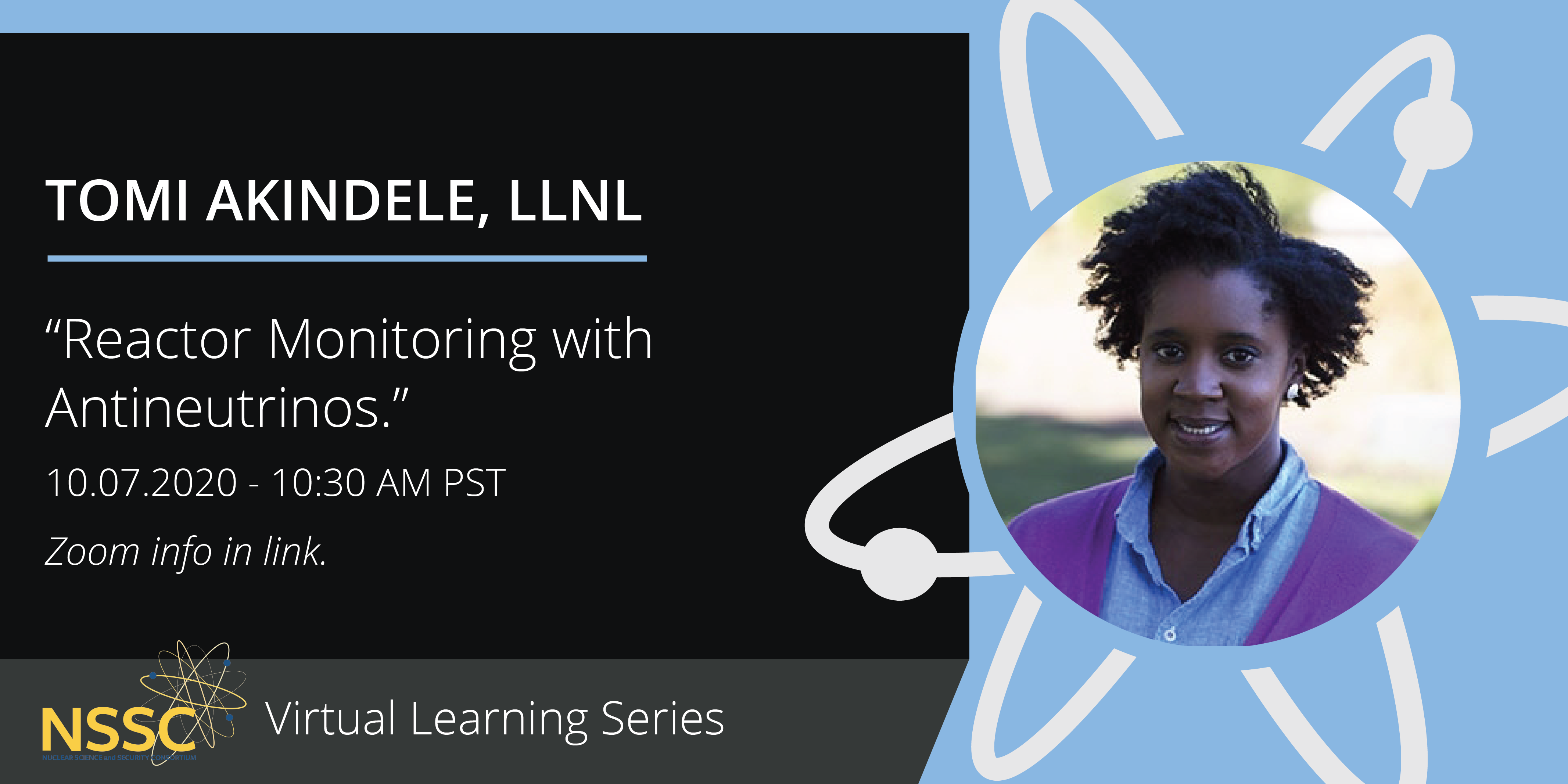

Abstract
To date, antineutrino experiments built for the purpose of demonstrating a nonproliferation capability have typically employed organic scintillator, and been situated as close to the core as possible typically a few meters to tens of meters distant, and have not exceeded a few tons in size. One problem with this approach is that proximity to the reactor core requires accommodation by the host facility. Water Cherenkov detectors located offsite, at distances of a few kilometers or greater, may facilitate non-intrusive monitoring and verification of reactor activities over a large area. As the standoff distance increases, the detector target mass must scale accordingly.
This article quantifies the degree to which a kiloton-scale gadolinium-doped water Cherenkov detector can exclude the existence of undeclared reactors within a specified radial distance, and remotely detect the presence of a hidden reactor in the presence of declared reactors. The detector presented here is based on the WATCHMAN collaboration’s 2019 baseline Gd-H2O Water Cherenkov detector design. This detector design is one of several variants on water-based detectors under consideration for deployment at the Advanced Instrumentation Testbed (AIT). AIT is a joint US-UK initiative to demonstrate reactor monitoring capabilities that may be relevant for future nonproliferation missions. The agreed location for AIT is in the Boulby mine in Northern England. In this article, antineutrino signals from reactors, and other location-dependent and depth-dependent backgrounds are taken to be those specific to the planned AIT site. At this location, reactor backgrounds are relatively high, providing a stringent test of the monitoring approach. A Feldman-Cousins based likelihood analysis was used to quantify the detector’s ability to exclude the existence of undeclared reactors. The analysis incorporates the distance to a hypothetical undeclared low-power reactor, and the reconstructed antineutrino energy distribution.
Bio: Tomi Akindele is a postdoctoral researcher at Lawrence Livermore National Laboratory. She received her PhD in nuclear engineering from the University of California, Berkeley, in 2018; with her dissertation focusing on expanding the surrogate reaction to measure prompt fission neutron multiplicities from unstable actinides. She received her undergraduate degree from Texas A&M in nuclear engineering in 2013. Her current research focuses on applied antineutrino detection for monitoring nuclear reactors and the investigation of water-based liquid scintillator for the next generation of kiloton-scale detectors.
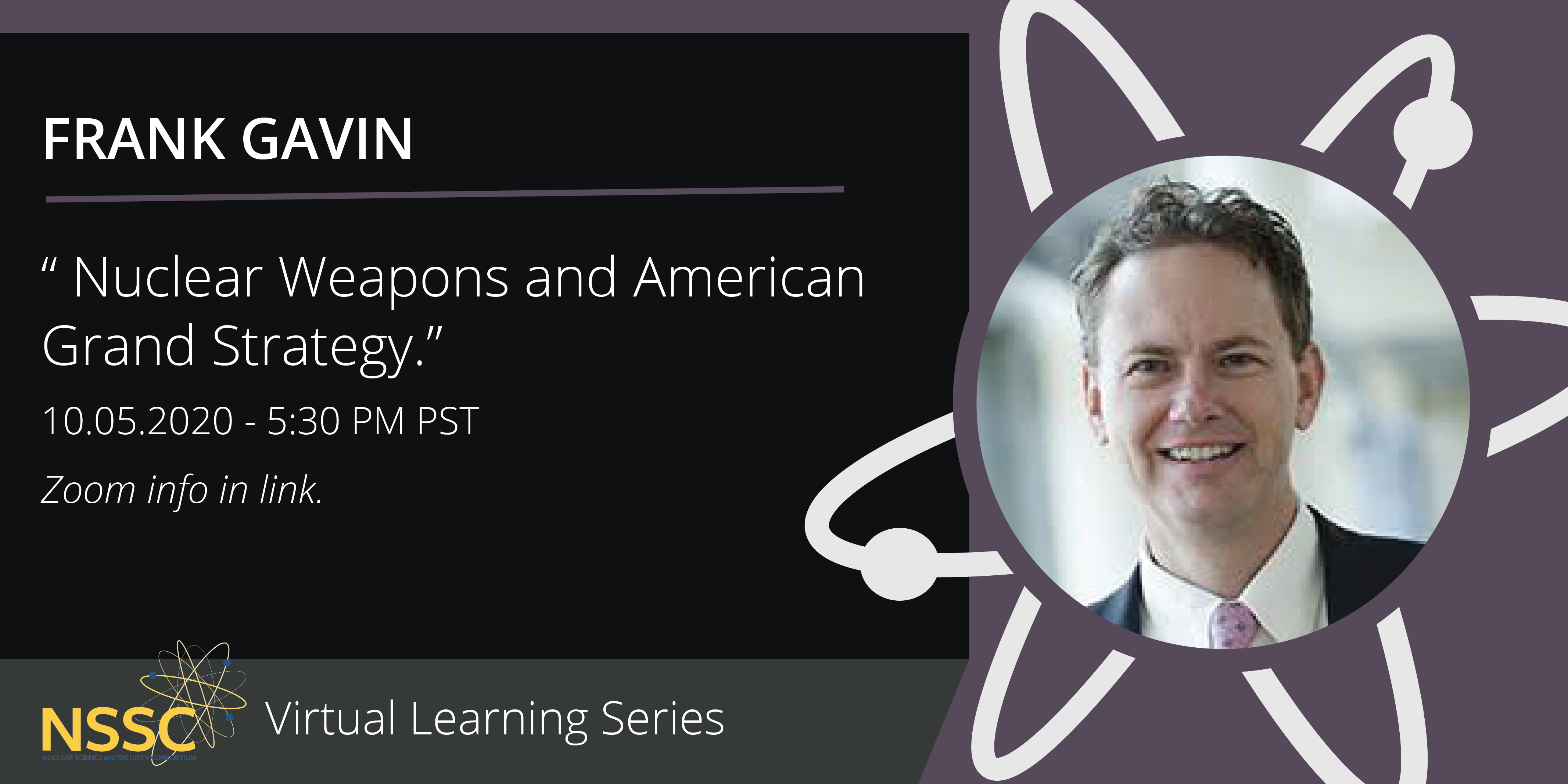
The world first confronted the power of nuclear weapons when the United States dropped atomic bombs on Hiroshima and Nagasaki in August 1945. The global threat of these weapons deepened in the following decades as more advanced weapons, aggressive strategies, and new nuclear powers emerged. Ever since, countless books, reports, and articles—and even a new field of academic inquiry called “security studies”—have tried to explain the so-called nuclear revolution.
Francis J. Gavin argues that scholarly and popular understanding of many key issues about nuclear weapons is incomplete at best and wrong at worst. Among these important, misunderstood issues are: how nuclear deterrence works; whether nuclear coercion is effective; how and why the United States chose its nuclear strategies; why countries develop their own nuclear weapons or choose not to do so; and, most fundamentally, whether nuclear weapons make the world safer or more dangerous. These and similar questions still matter because nuclear danger is returning as a genuine threat. Emerging technologies and shifting great-power rivalries seem to herald a new type of cold war just three decades after the end of the U.S.-Soviet conflict that was characterized by periodic prospects of global Armageddon. Nuclear Weapons and American Grand Strategy helps policymakers wrestle with the latest challenges. Written in a clear, accessible, and jargon-free manner, the book also offers insights for students, scholars, and others interested in both the history and future of nuclear danger.
Bio: Francis J. Gavin is the Giovanni Agnelli Distinguished Professor and the inaugural director of the Henry A. Kissinger Center for Global Affairs at SAIS-Johns Hopkins University. In 2013, Gavin was appointed the first Frank Stanton Chair in Nuclear Security Policy Studies and Professor of Political Science at MIT. Before joining MIT, he was the Tom Slick Professor of International Affairs and the Director of the Robert S. Strauss Center for International Security and Law at the University of Texas. Gavin is the Chairman of the Board of Editors of the Texas National Security Review. His writings include Gold, Dollars, and Power: The Politics of International Monetary Relations, 1958-1971 and Nuclear Statecraft: History and Strategy in America’s Atomic Age. His latest book, Nuclear Weapons and American Grand Strategy, was published by Brookings Institution Press in 2020.
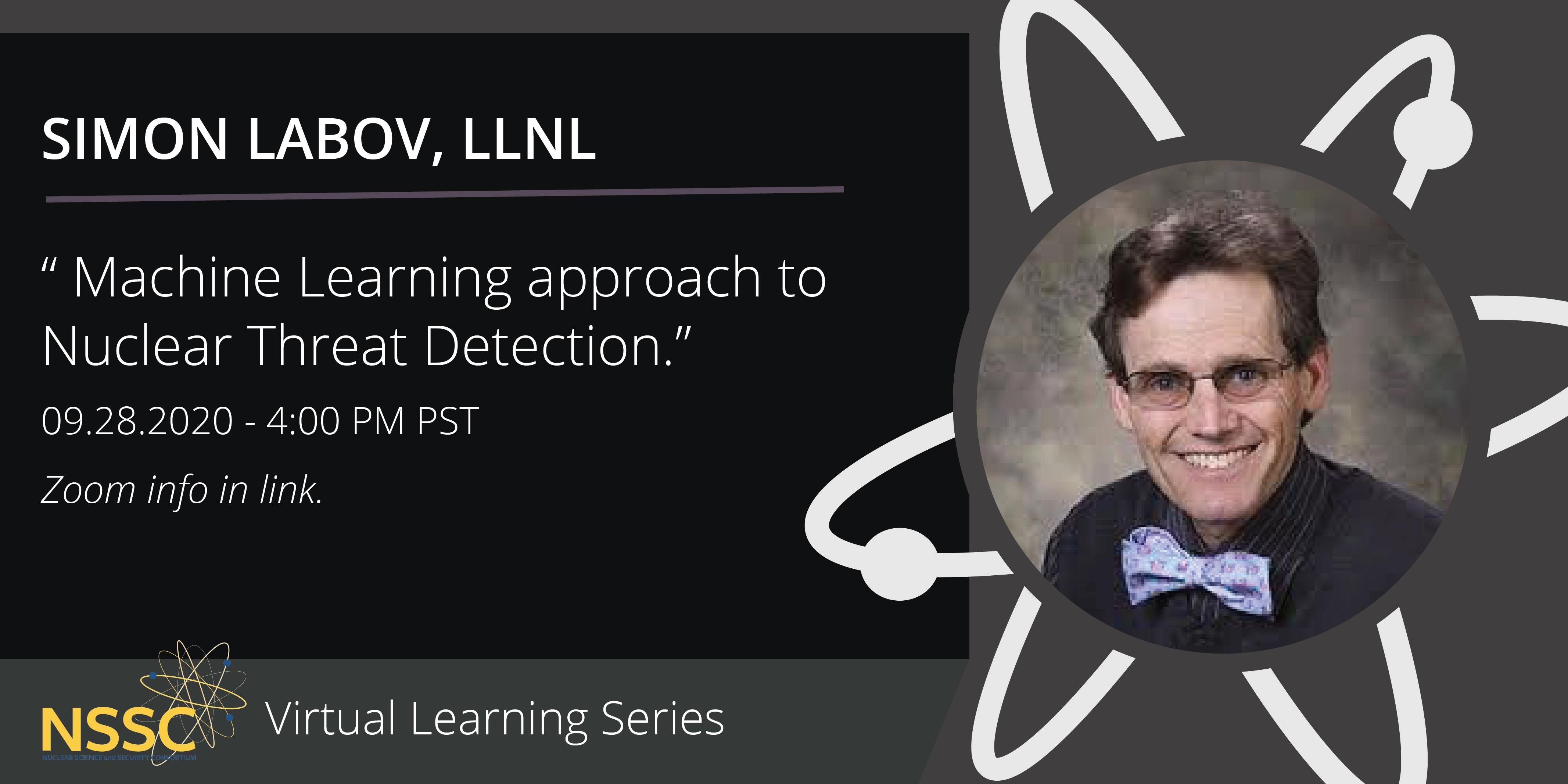
Conventional approaches to radiation measurements are sometimes insufficient to address the challenges of nuclear threat detection in real-world conditions. Threat-aware signal processing, statistical methods, machine learning and artificial intelligence are fast becoming an important part of the analysis of large data sets acquired by radiation detectors and supporting contextual sensors. These computational methods enable us to unmask data correlations, trends, and patterns that provide valuable insights of the physics phenomena under study. The methods and insights can then be used to fuse data from different measurement modalities and analyze measurements with greatly enhanced performance. This talk will describe some of the difficulties in nuclear threat detection and how machine learning can be applied to address these challenges. Problems specific to applying machine learning to nuclear threat detection, some of which can be catastrophic, will be discussed, and solutions will be presented that can avoid these issues.
Bio: Simon Labov is an expert in nuclear detection systems, advanced spectral and multisource analysis algorithms, and distributed detector systems. He currently leads development of the machine learning enabled Enhanced Radiological Nuclear Inspection and Evaluation (ERNIE) System. ERNIE is now operating at some of the busiest U.S. seaports to increase sensitivity and reduce false alarms for radiation portal monitors. He also leads an algorithm development team for the ubiquitous detection SIGMA program, and other mobile detection systems. In 2001, he initiated the Cellular-Telephone-Based Radiation Sensor and Wide-Area Detection Network Project, which was awarded three patents and has been aggressively supported by multiple funding agencies. Simon Labov joined LLNL in 1987 and helped initiate a program to develop high-resolution, energy-dispersive x-ray detectors that operate at very low temperatures, and then founded and directed the LLNL Radiation Detection Center. Prior to joining LLNL, Labov developed instrumentation for soft-x-ray astrophysics and received a B.S. at Stanford University and a Ph.D. at the University of California, Berkeley.
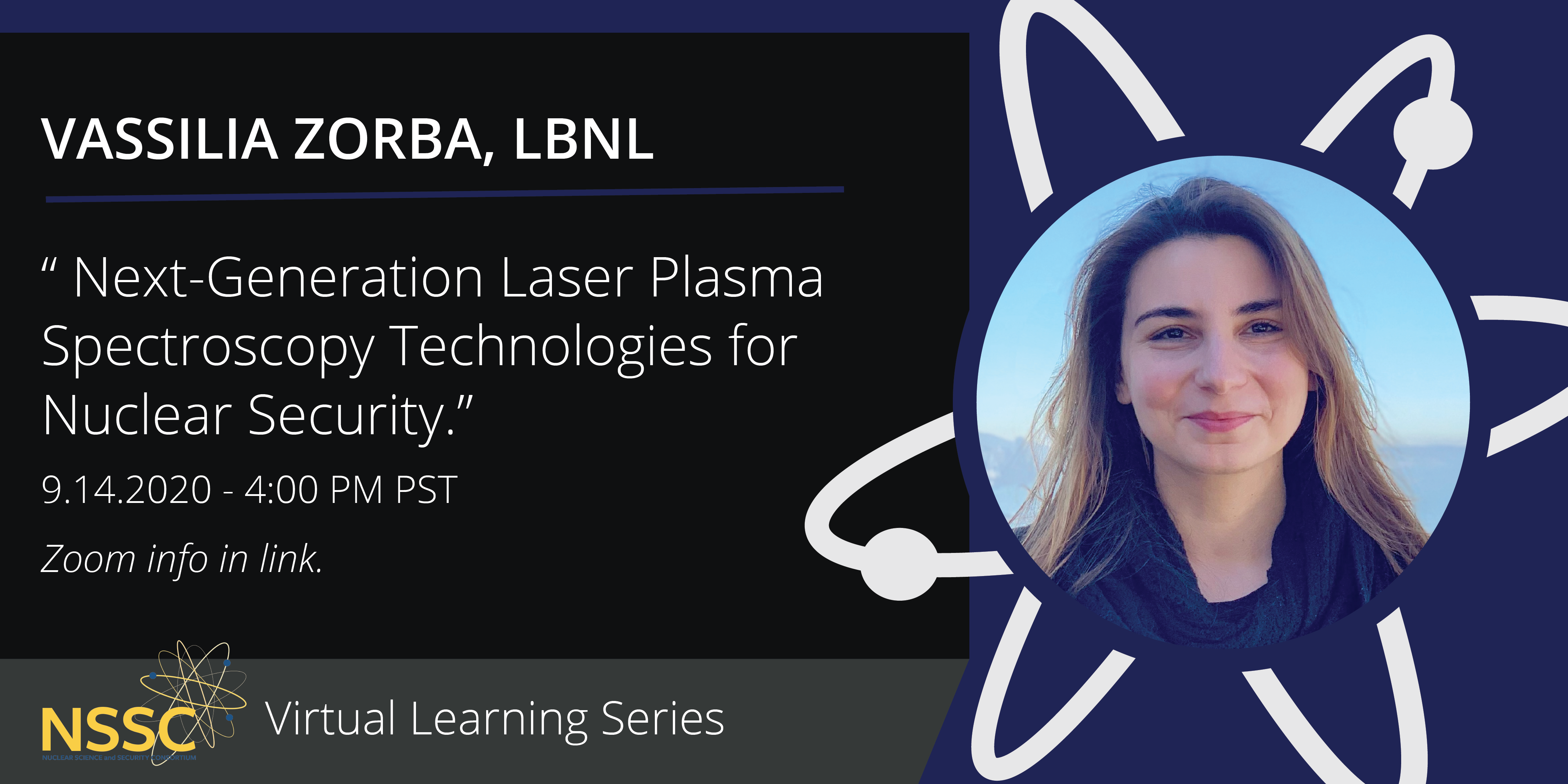
Abstract: Pulsed laser technologies play a critical role in nuclear security, including remote sensing, safeguards, and emergency response. My group’s research focuses on the development of next-generation laser technologies with improved sensitivity, precision, and detection range for nuclear non-proliferation applications. This talk will cover recent work on emerging ultrafast technologies based on optical emission. Specifically, I will discuss new femtosecond laser ablation sampling approaches that enable remote isotopic and elemental sensing, improve laser beam propagation at extended distances, and preferentially enhance or impede chemical reactions for the detection of isotopes. Enabling laser technologies to include femtosecond filamentation, ultrafast optical vortex beams, and femtosecond-induced weakly ionized air plasma channels to optimize detection distance and sensitivity.
Bio: Dr. Vassilia Zorba is a Physicist Staff Scientist and Group Leader for the Laser Technologies Group at the Lawrence Berkeley National Laboratory. She is also an Associate Adjunct Professor in the Department of Mechanical Engineering of the University of California, Berkeley. Her research interests include ultrafast laser-material interactions, non-linear optics, remote sensing, laser-induced plasma chemistry, and laser ablation-based chemical analysis for nuclear security and energy applications. Her previous work focused on femtosecond laser surface structuring technologies and biomimetic material functionalization. Dr. Zorba’s credits include more than 70 publications in peer-reviewed journals, numerous invited talks, and a 2011 R&D 100 Technology Award.
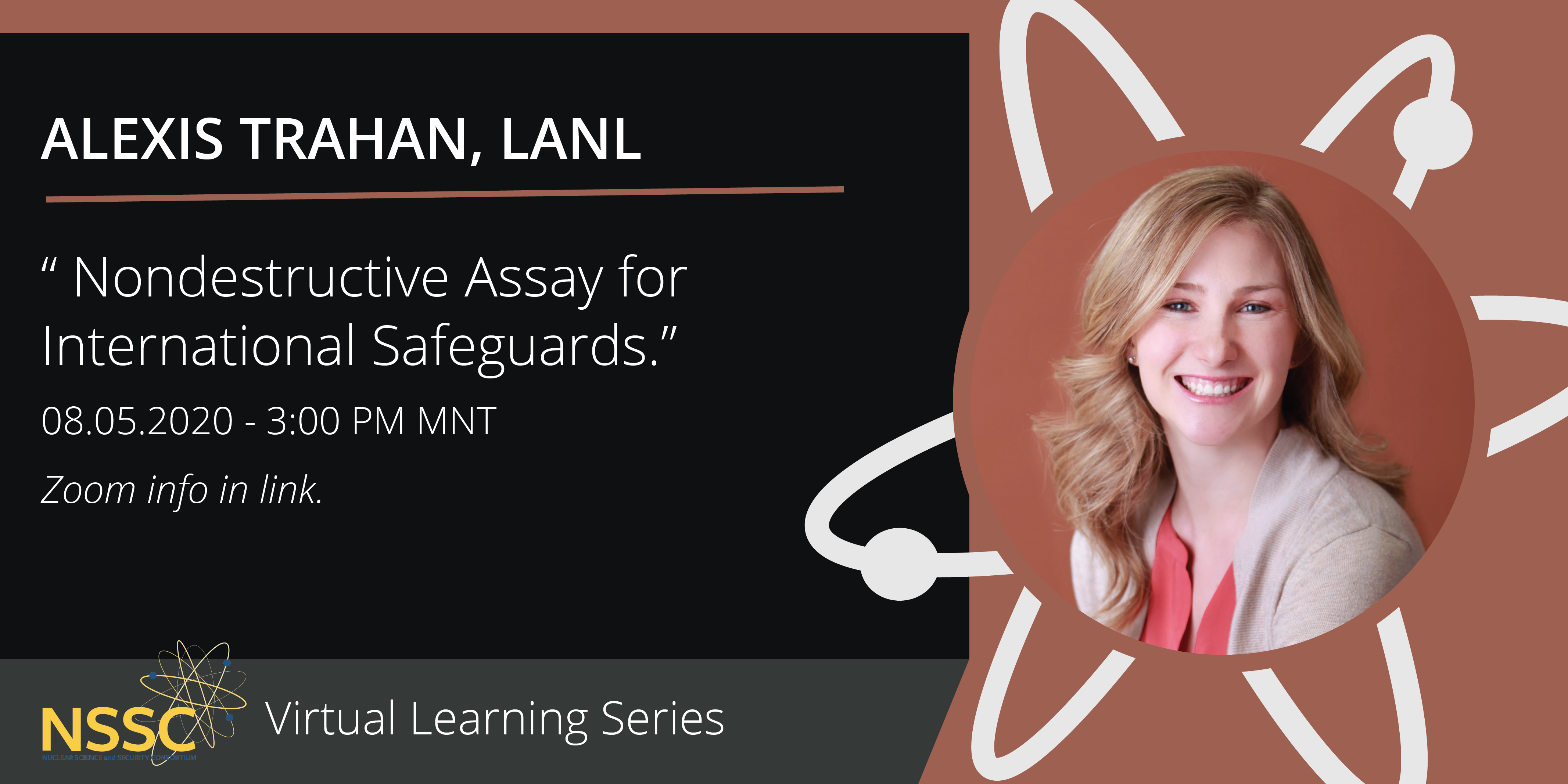
The International Atomic Energy Agency (IAEA) is responsible for ensuring the timely detection of diversion of nuclear material from peaceful nuclear programs to illicit weapons programs. This mission is accomplished through implementation of Nuclear Safeguards. At Los Alamos National Laboratory (LANL), we support the IAEA in this crucial mission through development of nondestructive assay (NDA) technology and analysis methods. This talk will provide an introduction to International Safeguards and an overview of NDA technology and methodologies for verification, as well as highlight current NDA and Safeguards research taking place at LANL.
Dr. Alexis Trahan is an R&D Engineer with the Safeguards Science and Technology group and the Senior Project Lead for NA-241 International Nuclear Safeguards at LANL. She received her B.S. in nuclear engineering from UC Berkeley in 2011 and her M.S. and Ph.D. from the University of Michigan in 2012 and 2016 respectively. Alexis works on development of detection instrumentation and analytical methods with an emphasis on neutron detection for nonproliferation. She is currently developing and testing technologies for used power reactor and research reactor fuel characterization. Alexis is also actively engaged with the Nuclear Compliance Verification program as the LANL Project Lead.
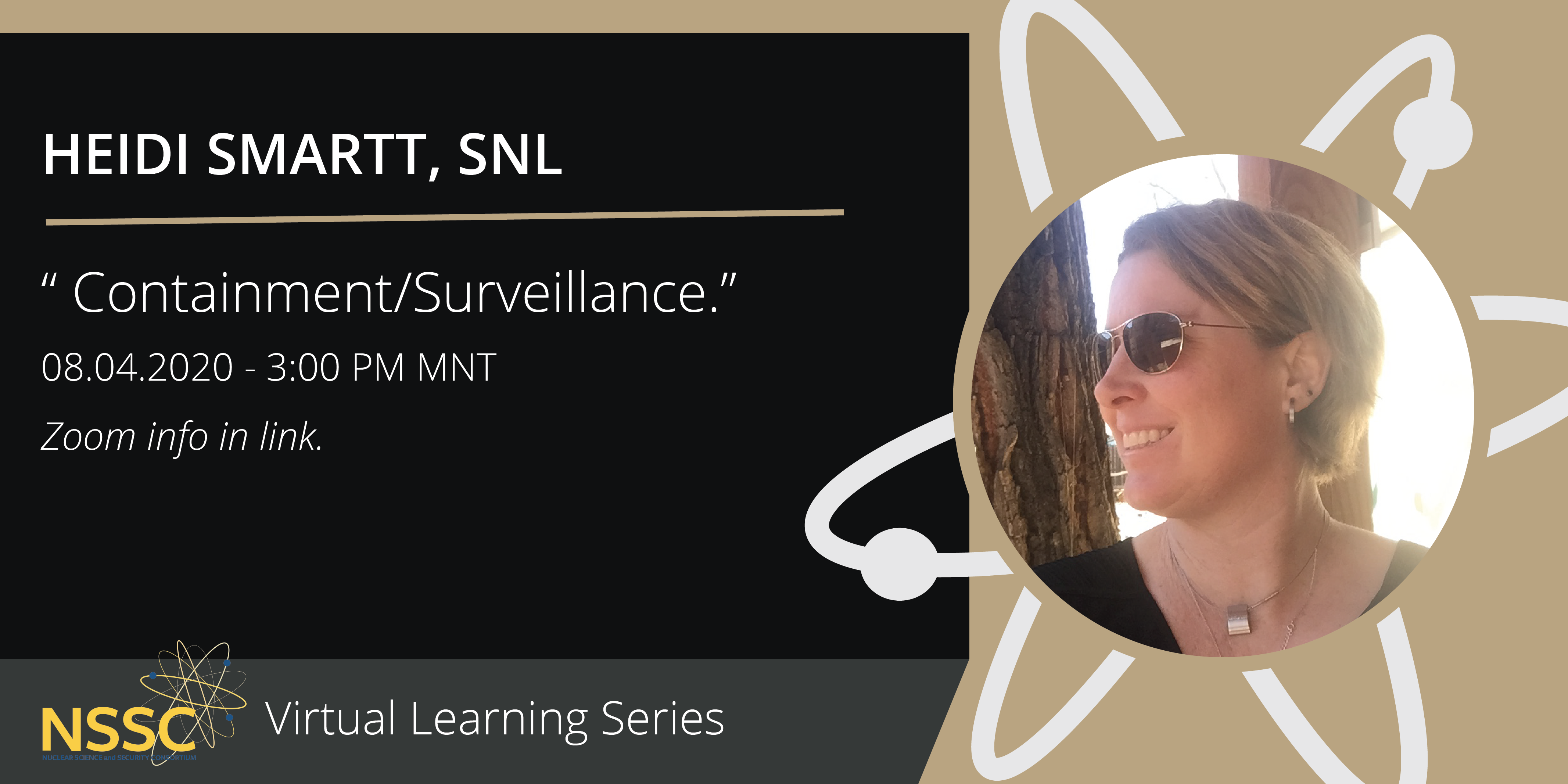
This talk explains the relationship of Containment/Surveillance with the Nuclear Nonproliferation Treaty (NPT), provides definitions and considerations for Containment/Surveillance, and provides examples of technologies that are currently deployed.
Dr. Heidi A. Smartt is a Principal Member of the Technical Staff in the International Safeguards and Engagements department at Sandia National Laboratories in Albuquerque, New Mexico. She received her Ph.D. in Electrical Engineering from the University of New Mexico in 2005 with an emphasis in Applied Electromagnetics. Heidi has worked in nuclear nonproliferation since 1997 with early work focused on remote monitoring systems and information assurance for communication systems in international safeguards. While working on her Ph.D., Heidi gained experience in spectroscopy and imaging systems, eventually completing her dissertation on methods to improve the detection of targets with both spatial and spectral characteristics in hyperspectral imagery. Her more recent research interests have involved tags, tamper-indicating devices, tamper-indicating enclosures, and Containment/Surveillance approaches and technologies.
Recordings of NSSC webinars held prior to Summer 2020 are available here.
